The best self-fertile pear varieties: growing features
Fragrant and fragrant pears grow in most Russian gardens. The fruits are used for processing and sale, eaten fresh and dried for the winter. The sweet pulp is used to make winter preparations, desserts, and fluffy pastries. To get a rich harvest, it is important to take into account a number of characteristics when choosing a variety: the color and size of the fruit, the density and sugar content of the pulp, the nuances of care and ripening time. One of the important criteria is self-fertility. What are self-fertile pear varieties and what are their advantages, we will consider in the article.
Characteristics and description of self-pollinating pear varieties
Self-pollinating (self-fertile) pears grow independently and do not require pollinating insects (wasps, bees) or other trees to ripen. The opposite of such varieties are self-fertile pears, which are pollinated by pollen from nearby growing garden plants.
Reference. Self-fertile varieties are unpretentious in planting and growing. They do not require special care, so any amateur gardener can grow a rich harvest.
Such trees are suitable for cultivation in the middle zone of the country and northern regions, where due to frequent winds and rains, pollen does not reach the flowers. Plants are planted in masses or individually, depending on the size of the plot.
Popular varieties of self-fertile pears
Experienced gardeners recommend buying seedlings of self-fertile pears from trusted agronomists. Two-year-old specimens are suitable for planting in Russian climatic conditions.Seedlings should be light brown, elastic, without mechanical defects and signs of damage by diseases and pests.
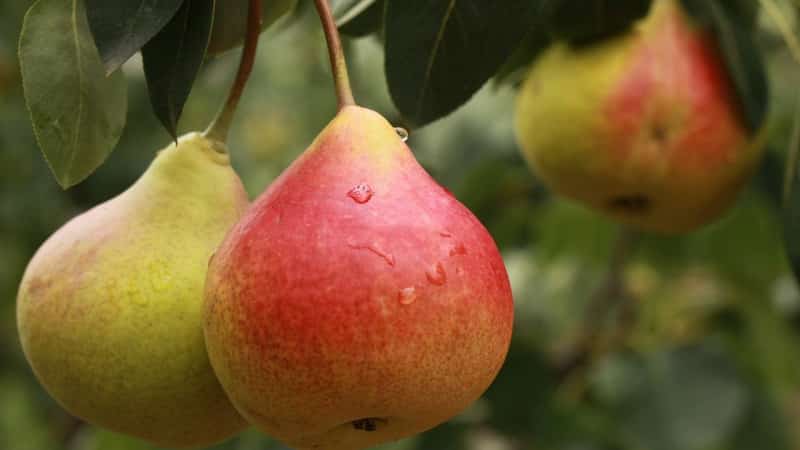
Memory of Timofeev
Summer residents value the Pamyat Timofeev pear for its frost resistance. The variety is grown in cold regions of the country - in the Urals and Siberia. Seedlings quickly take root in the soil and adapt well to climatic conditions. The height is average, the crown is compact - the tree does not take up much space, suitable for planting in small areas. The fruits are green-yellow, with a pinkish side, and have a classic pear-shaped shape. The pulp is creamy, fine-grained, the taste is juicy and harmonious, the skin is of medium thickness. The harvest ripens at the same time. Juices, compotes, preserves, and jams are prepared from pears. Memory of Timofeev is good and fresh.
This variety grows best on loamy soils. For the culture, choose a bright area, remove old leaves and debris, dig a hole and fertilize it with a mixture of cow manure, peat and humus. In the first few days, the pear is watered generously with warm water. After a week, the soil is moistened once every 2-3 weeks.
Tenderness

The trees are vigorous, reaching a height of 6 m, with a columnar crown. The branches are sparse, the leaves are dark green glossy. The fruits ripen 4 years after planting, the shape is pear-ovate. Weight - from 150 to 200 g. Color yellow-green, with a pinkish blush. The peel is of medium density, there is a slight waxy coating on the surface. Ripening begins in the second ten days of August and continues until mid-September. The pulp is creamy, tender and juicy, the taste is sweet and sour and aromatic. Tenderness can withstand temperatures down to -40°C, so it is suitable for planting in the coldest regions of the country. During the season, the tree produces up to 30 kg of harvest.
Reference. Summer and autumn pears are indispensable for preparing desserts and drinks. They are used to prepare pies, crumbles, warm salads, muffins, confitures and even condensed milk.
The fruits do not spoil within a month after being picked from the tree and retain an attractive presentation. The variety is grown in small garden plots and large agricultural farms. The tree prefers loose and breathable soils, sunny and slightly elevated areas. Moderate humidity is important for Tenderness - too much water causes rotting of the root system.
In memory of Yakovlev
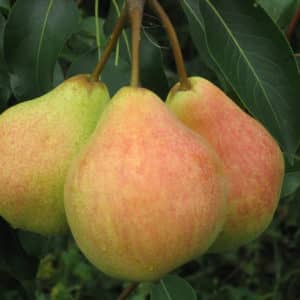
The variety is recommended for planting in the Central, Volga-Vyatka, and Middle Volga regions. Ripening period is early autumn, winter hardiness is increased. The tree is low-growing, with a dense and compact crown, the leaves are dark green. The main shoots grow parallel to the ground. The fruits are slightly ribbed, average weight - 125 g. The skin is light yellow, with a slight blush, the stalk is long and straight. The pulp is semi-oily, creamy, sweet, with a slight sourness and strong aroma. Pears are suitable for processing and making compote, jam, marmalade, and tolerate transportation well.
Despite the self-fertility, to increase productivity, summer residents plant other pear varieties nearby: Banketnaya, Lada, Tenderness. This method of cultivation stimulates flowering and fruit set. The distance between plants should be at least 3-4 m - planting too close provokes the development of diseases.
Noticeable
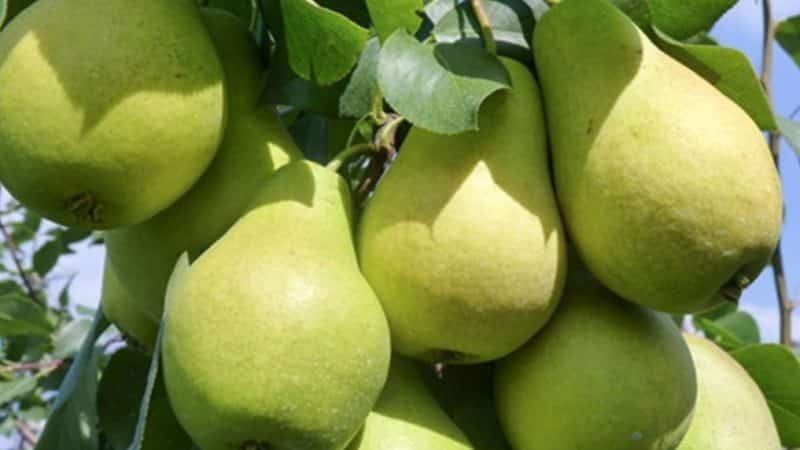
The noticeable one got its name due to its large fruits: the weight of a pear is about 180 g, it is difficult not to notice it in the garden plot. The color is yellow-green, the shape is short pear-shaped, the peel is dense, with a small dark dot. The pulp is white, juicy, has a dessert taste and is not sour. Tasting score: 4.6 points.Ripening period is late autumn, noticeable is used for sale, transportation, storage.
The trees are tall and powerful, so it is recommended to think about the planting location in advance. During the season, the plant produces from 30 to 40 kg of harvest, depending on climatic conditions and compliance with agrotechnical rules. Recommended growing regions are the Urals and the middle zone of the country. The noticeable pear does not need pollinators.
Attention! For long-term storage, pears are removed from the trees unripe so that they ripen later. Use a box with holes for air, lay paper on the bottom and walls. The fruits are laid out with the stalk facing up so that they do not touch each other. The box is placed in a disinfected cellar or basement.
Notably resistant to scab and downy mildew, rarely damaged by insects. Suitable for planting in the Leningrad region. However, it is important not to forget about carrying out preventive measures: spray trees with Bordeaux mixture (after flowering - 1% solution, up to - 3%), treat with Merpan.
Grand Champion
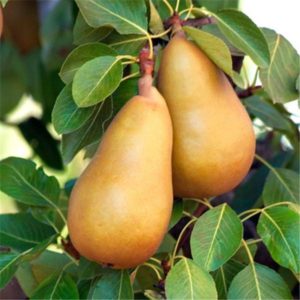
An American variety, ripening in autumn, harvested in late September or early October. Trees of medium vigor, compact pyramidal crown, average density. The fruits are large, the weight of one reaches 220 g. The shape is elongated pear-shaped, the surface is slightly ribbed. The color is golden-orange, with small brown dots throughout the surface of the fruit. The pulp is oily, very tender and juicy, sweet and sour, aromatic. Tasting score: 4.8 points. The variety is early-bearing and begins to bear fruit 3 years after planting. The pears do not fall off and are universal in use. Grand Champion is resistant to powdery mildew, rust, and scab.
Attention! Do you need a pollinator for Champion pear? No, but having other varieties nearby will increase yields by 15–20%.
To speed up the ripening of fruits, gardeners recommend foliar feeding 3-4 times per season. In the fall, prepare a mixture of 30 g of superphosphate and 15 g of potassium chloride, add 150 ml of wood ash. In the spring, add 50 g of nitroammophoska (30 liters of mixture is enough for 1 m²). Foliar feeding strengthens the plant’s immunity and protects against diseases.
Banquet room
The ripening period is late, the harvest is harvested from mid-October to the end of autumn. Banquetnaya is planted in Moscow region. The trees are of medium height, the crown is very dense. The leaves are large, green, slightly dissected, the branches grow upward. Pears are round, yellow-green, with a slight blush, weight - about 250 g. The peel is dense, so the fruits are used for transportation and storage. The pear is stored in the refrigerator until the end of January. The flesh is beige, semi-oily and juicy. The taste is sweet and sour.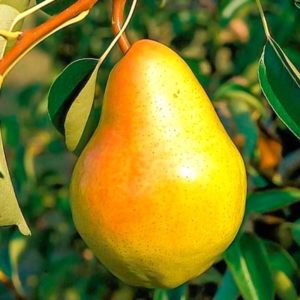
Fruiting occurs 3 or 4 years after planting, the variety is high-yielding - the tree produces up to 40 kg of fruit annually. The purpose of the variety is universal: juices and compotes, jams and preserves are made from pears, marmalade, marshmallows, marshmallows, and jelly are prepared.
Growing Banquet does not require special skills and knowledge, but due to the dense crown it needs regular shaping. Annual seedlings are cut to a height of 80 cm, leaving only those buds that are required for the growth of young shoots. In mature trees, attention is paid to thinning the crown, cutting out diseased and dry shoots, and shortening overgrown branches.
Conclusion
Pollination of pears requires insects or nearby varieties. In order not to worry about this, summer residents choose self-pollinating varieties for growing.Grand Champion, Memory of Yakovlev, Banketnaya and Zametnaya are grown on the plots. They are unpretentious in care and planting, bear fruit well in any region of Russia, and are frost-resistant. Most pears are suitable for storage in the basement or refrigerator, suitable for fresh consumption, processing, drying, and canning. The soft and tender pulp of the fruit is used for cooking compotes and jam.